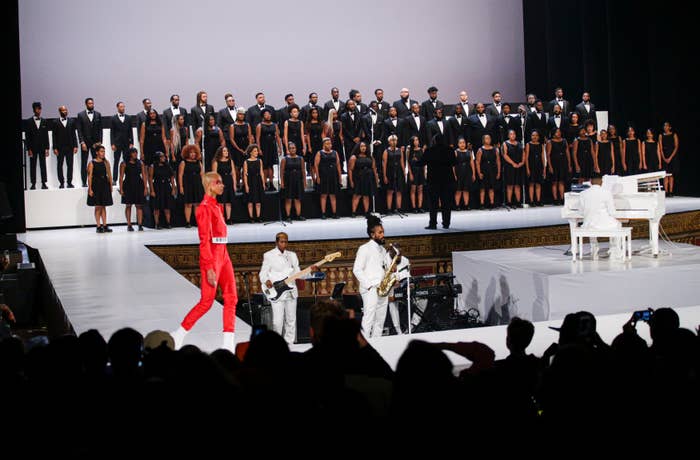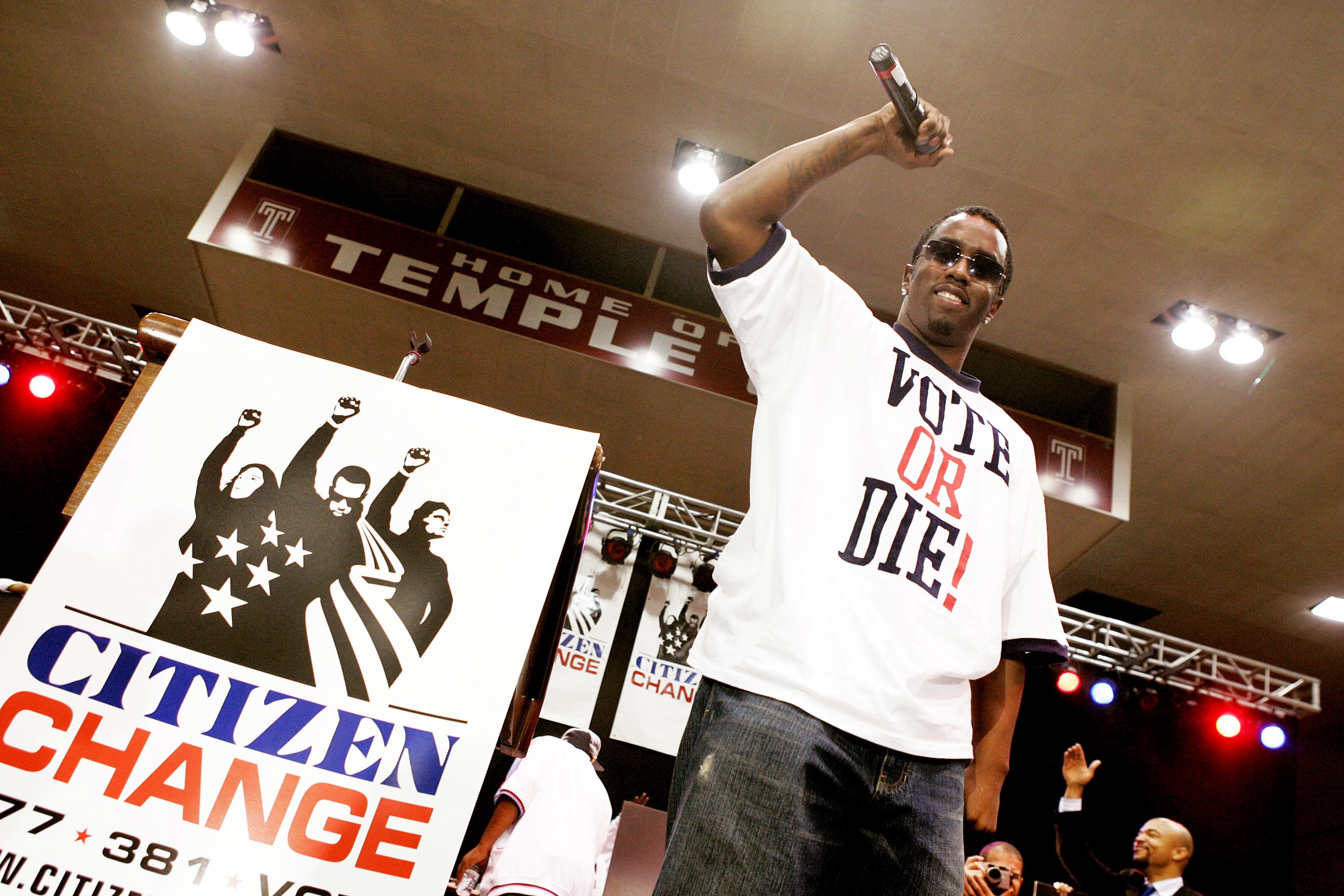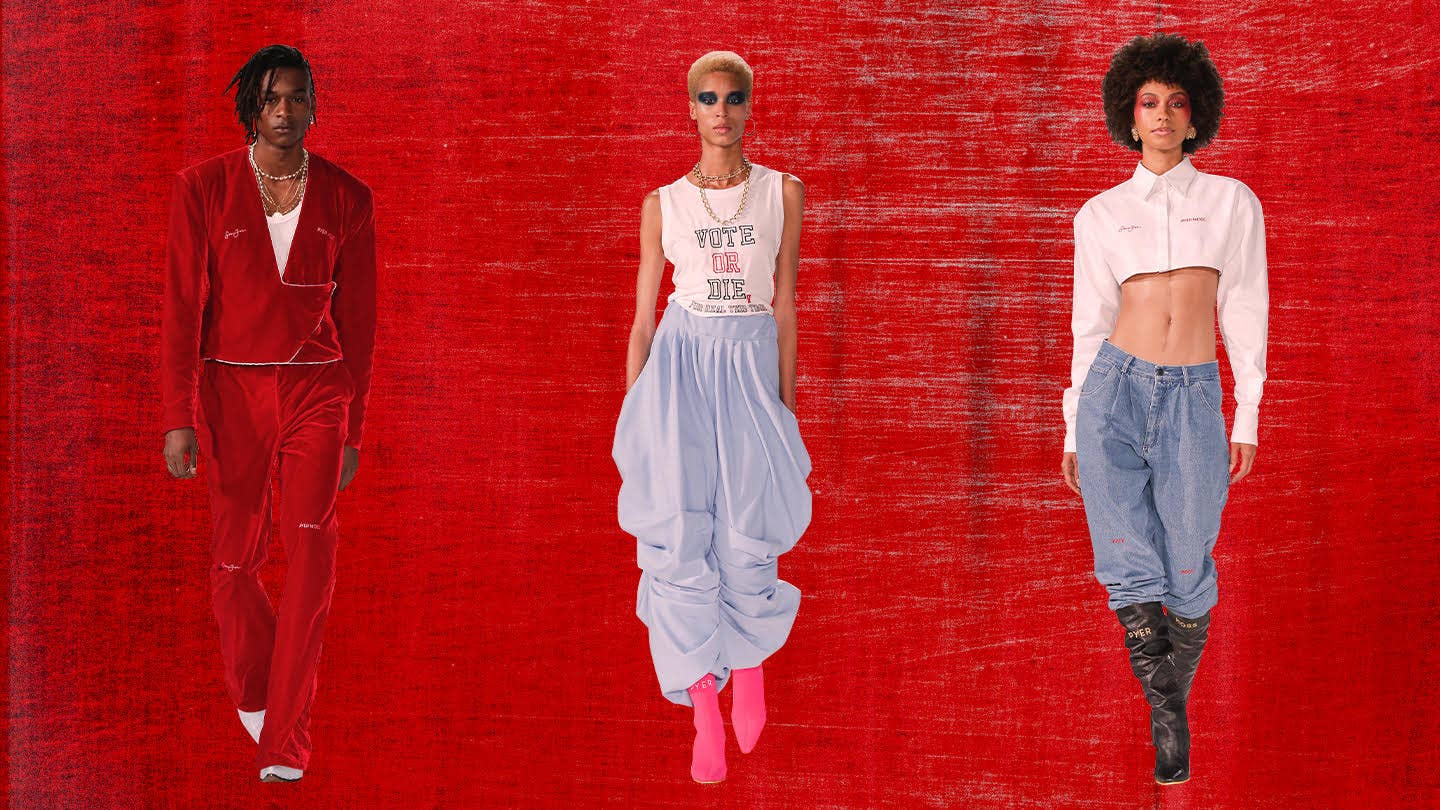
Almost 20 years ago, E! decided to do something that hadn't been done: film a fashion show and air it live on national TV via its own network and its now-defunct sister channel, the Style Network. They smartly chose to shoot Puff Daddy's debut Sean John show during New York Fashion Week.
Puffy wasn’t the first person coming from hip-hop to launch a brand and host a fashion show—see Phat Farm—but his high-production shows and aspirational clothes that mixed street with luxury while embracing black culture was a new concept.
You see traces of Puffy’s ideas today with designers including Kerby Jean-Raymond of Pyer Moss, who collaborated with Sean John for his "Sister" Collection 3 show, which was held at the Kings Theatre in Brooklyn earlier this month. Before the show even started, a guest in the audience likened the energy in the room—celebrities including Quavo, Takeoff, Normani, Saweetie, and Kehlani sat front row—to Puffy's fashion shows that took place in the early 2000s.
The event opened with a performance from Brent Faiyaz and a speech from writer Casey Gerald, and models walked down the runway to music provided by the The Pyer Moss Tabernacle Drip Choir Drenched in the Blood, a 90-person group Jean-Raymond put together that performed everything from Anita Baker's "Sweet Love" to Cardi B's "Money."
"I was talking to Puff about it, and I was like, 'Yo, he really captured what we used to do with our front row and his showmanship,'" says Jeff Tweedy, the president of Sean John, who helped Puffy turn the brand into a multimillion-dollar business. "And it's good to see that somebody's doing that again and not just rolling clothes down the runway."
Here, we speak to Tweedy about the collaboration with Pyer Moss, the popularity of the "Vote or Die" T-shirts, how the fashion industry has evolved in terms of race, and Sean John’s impact.
(This interview has been edited and condensed for clarity.)

How did this collaboration come about?
It was his idea. I met Kerby [Jean-Raymond] in 2004. I actually gave him a scholarship when I was a board member at the Black Retail Action Group (BRAG). I gave him a $25,000 scholarship, which really started his business. And he reminded me of that, and I was like, "Wow, I do remember now." We met in our office. He came over and we talked about an opportunity and I loved the opportunity. I said, "Yeah, we should do something together." He wanted to see what things we've done in a fashion show in the past. He had something in mind, and he knew that some of the staples were important to us. He knew velour was important to us, he knew Vote or Die was a moment for us, and those are really the things that he wanted to work with and I was excited about that.
How well did that "Vote or Die" T-shirt do when it was first released?
Extremely well. And we brought it back. We re-released them last year when we celebrated our 20th anniversary. Between its original release and last year, we’ve sold about 160,000 "Vote or Die" T-shirts.

One thing I overheard at the show was that it felt like what a Sean John or Baby Phat show felt like. What did you think?
You know, it was so funny because I was talking to Puff about it, and I was like, "Yo, he really captured what we used to do with our front row and his showmanship." He really did it. And it's good to see that somebody's doing that again and not just rolling clothes down the runway. You know, when we started Sean John, it was very important that we combined fashion with entertainment. And that's why we coined the word "fashiontainment." And that was important to us because people want to be entertained, you know.
Did you also see an evolution of how things in the industry have changed since Sean John was putting on shows in the early 2000s?
Of course. The biggest evolution was the opening statement from Casey Gerald—when he said, "I'm free." Talk about evolution. That's what we are today. And that’s why his statement was so important. The first runway show we did in 2000, people looked at us like, "Who the hell is he to do a show? Who does he think he is? He's an entertainer. I want to see you dance." And we knew that basically people would have, for lack of better words, bricks under the seat, waiting to throw them at us. What they didn't understand is that we took the steps before we took the elevator. We did our homework. I tell young designers this all the time. So if you look before 2000, before we launched Sean John, Puff was at everyone's fashion show. Puff was at Tommy Hilfiger; he was having lunch with Anna Wintour. We did our homework. We learned and embraced the fashion world. And I already had 15 years experience from Ralph Lauren, Hugo Boss, Spike Lee, and Karl Kani, so I was well vested in it. But for him, he took the time to embrace these people who were sitting front row at shows.

Do you think that when Puffy just started in fashion, he could have been as outspoken about race as Kerby is?
No. Times have changed. It's all about equality now. There's a new voice and movement out there, but if you're looking back at some of our shows, they were always pretty racy with some of the things we were saying. We would play music Gil Scott-Heron or Public Enemy.
What do you think has been Sean John’s impact?
I think the biggest impact is that we took a brand for the African-American consumer and made it aspirational. People thought the only aspirational brand at the time was Ralph Lauren. In the ad campaigns, there were beautiful mansions, and beautiful cars, and you know, the white wife riding around on a horse. And you thought that was the future, that's the only way you could be a part of the lifestyle. And we came out and said, "No." We know how to throw parties, and we know how to have everybody dress up in the Hamptons in all white. We have beautiful girlfriends, too. Right? And we know how to drive the best cars and drink the best champagne. So our lifestyle was aspirational also, for everyone across the country, and it was slightly different than what Ralph Lauren was doing, which was aspirational for that consumer. We utilized Ralph Lauren's blueprint on how he does business, but we knew we had someone who's incredible at marketing, and that's Puffy.
But do you feel like that sort of aspirational marketing is still as relevant? Kerby markets his brand in a very socially conscious way.
What you said is very interesting. Having a voice is aspirational. Some people look up to having a voice. Some people look up to someone creating a collection with a voice. Aspirational doesn't mean that it has to cost a lot.
Kerby bought back Pyer Moss and has an important partnership with Reebok. I know for a while Sean John was privately held and had a partnership with Macy's, but only recently did Global Brands Group Holding Ltd. purchase a majority stake in the business. What's your advice to younger designers when it comes to ownership, investment, etc.
The thing that made Calvin Klein and Ralph Lauren so successful was that Calvin was the designer and he had Barry Schwartz to run the business. Ralph Lauren was designing and his brother Jerry [Lauren] ran the business. And I'm not comparing myself to him, but Puff was the designer and I ran his business. So I think that you've got t to find a balance of someone who's as knowledgeable on how to run the business. Someone who will help you develop it financially and make sure it's profitable. It's very difficult for a designer to design and try to finance the company.

